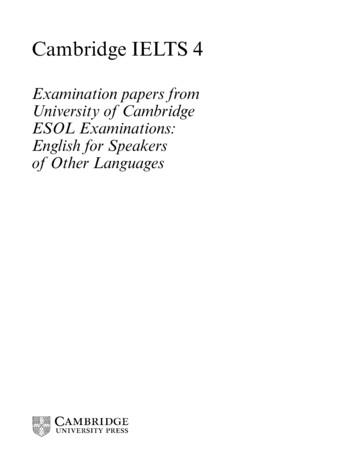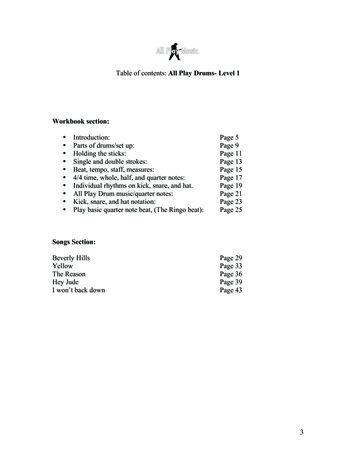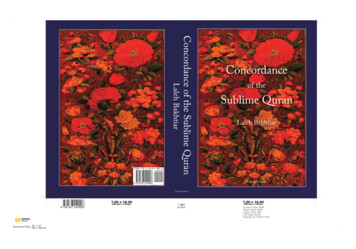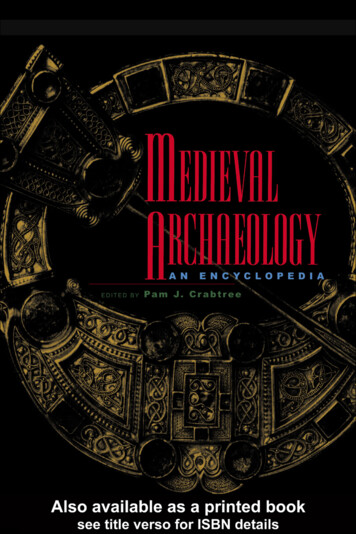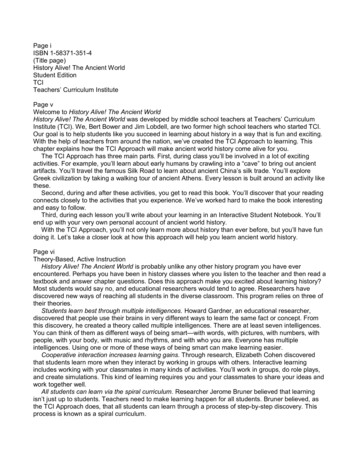
Transcription
Page iISBN 1-58371-351-4(Title page)History Alive! The Ancient WorldStudent EditionTCITeachers’ Curriculum InstitutePage vWelcome to History Alive! The Ancient WorldHistory Alive! The Ancient World was developed by middle school teachers at Teachers’ CurriculumInstitute (TCI). We, Bert Bower and Jim Lobdell, are two former high school teachers who started TCI.Our goal is to help students like you succeed in learning about history in a way that is fun and exciting.With the help of teachers from around the nation, we’ve created the TCI Approach to learning. Thischapter explains how the TCI Approach will make ancient world history come alive for you.The TCI Approach has three main parts. First, during class you’ll be involved in a lot of excitingactivities. For example, you’ll learn about early humans by crawling into a “cave” to bring out ancientartifacts. You’ll travel the famous Silk Road to learn about ancient China’s silk trade. You’ll exploreGreek civilization by taking a walking tour of ancient Athens. Every lesson is built around an activity likethese.Second, during and after these activities, you get to read this book. You’ll discover that your readingconnects closely to the activities that you experience. We’ve worked hard to make the book interestingand easy to follow.Third, during each lesson you’ll write about your learning in an Interactive Student Notebook. You’llend up with your very own personal account of ancient world history.With the TCI Approach, you’ll not only learn more about history than ever before, but you’ll have fundoing it. Let’s take a closer look at how this approach will help you learn ancient world history.Page viTheory-Based, Active InstructionHistory Alive! The Ancient World is probably unlike any other history program you have everencountered. Perhaps you have been in history classes where you listen to the teacher and then read atextbook and answer chapter questions. Does this approach make you excited about learning history?Most students would say no, and educational researchers would tend to agree. Researchers havediscovered new ways of reaching all students in the diverse classroom. This program relies on three oftheir theories.Students learn best through multiple intelligences. Howard Gardner, an educational researcher,discovered that people use their brains in very different ways to learn the same fact or concept. Fromthis discovery, he created a theory called multiple intelligences. There are at least seven intelligences.You can think of them as different ways of being smart—with words, with pictures, with numbers, withpeople, with your body, with music and rhythms, and with who you are. Everyone has multipleintelligences. Using one or more of these ways of being smart can make learning easier.Cooperative interaction increases learning gains. Through research, Elizabeth Cohen discoveredthat students learn more when they interact by working in groups with others. Interactive learningincludes working with your classmates in many kinds of activities. You’ll work in groups, do role plays,and create simulations. This kind of learning requires you and your classmates to share your ideas andwork together well.All students can learn via the spiral curriculum. Researcher Jerome Bruner believed that learningisn’t just up to students. Teachers need to make learning happen for all students. Bruner believed, asthe TCI Approach does, that all students can learn through a process of step-by-step discovery. Thisprocess is known as a spiral curriculum.
These three theories are the foundation of the TCI Approach. Putting them into practice in HistoryAlive! The Ancient World gives you what you need to succeed.Page viiStandards-Based ContentA lot of people care about what you are learning in history. These people include your parents, yourschool administrators, your teachers, and even your state and national elected officials. In fact, if you’relike students in most states, you take tests at the end of the year to measure your progress.Most end-of-year tests are based on standards. Standards are the key pieces of information abouthistory that elected officials think are important for you to remember. When you read most standards,you might scratch your head and think, “These seem really hard to understand, and they’re probablyeven harder to learn and remember.” There’s no need to worry about that with History Alive! TheAncient World. Every lesson is based on standards. So every day, while you’re having fun learningancient history, you are also learning key standards.You’ll be recording everything you learn in your Interactive Student Notebook. When it’s time toprepare for tests, your notebook will make it easy to review all the standards you’ve learned.In fact, students across the nation using the TCI Approach are getting better scores than ever onstandardized tests. A big reason for this success is that the TCI Approach is based on interactivelearning. That means you won’t just read about history. You’ll be actively involved in experiencing it andrecording what you learn. Let’s take a look at what you’ll do during each part of a lesson with the TCIApproach.Page viiiPreview AssignmentsWith the TCI Approach, learning starts even before you begin studying. Most of the lessons inHistory Alive! The Ancient World begin with a Preview assignment. Previews are short assignmentsthat you complete in your Interactive Student Notebook. They allow you to make a personal connectionto what you will study.After you complete a Preview assignment, your teacher will hold a brief class discussion. Severalstudents will share their answers. Your teacher will then reveal how the assignment “previews” what isto come in the lesson.Here are some examples of the kinds of Preview assignments you will complete: Before studying the early civilization of Sumer in Chapter 5, you will complete a spoke diagram. You’lluse the diagram to show what you think are the characteristics of a civilization. Before studying ancient Egypt’s social pyramid in Chapter 9, you’ll draw a social pyramid for yourschool. You will arrange individuals and groups on your pyramid, including students, the principal,teachers, and the student council. Before learning about the golden age of India’s Gupta Empire in Chapter 18, you will write aparagraph about a “golden age” (a time of special accomplishment) in your own life. Before learning about Alexander the Great in Chapter 30, you will draw a figure to represent a goodleader. You’ll use the figure to show five qualities that you believe make a good leader.Preview assignments like these will spark your interest and get you ready to tackle new concepts.Next come the exciting activities that make up the heart of each lesson. As you’re about to see, theseactivities draw on many ways of being smart—our multiple intelligences.Page ixMultiple-Intelligence Teaching StrategiesThe teaching strategies in the TCI Approach are based on hands-on learning. Every lesson inHistory Alive! The Ancient World is built around a fun and exciting activity. We mentioned someexamples earlier. Here are some other things you and your classmates will do to experience ancienthistory:
For Chapter 7, you’ll use your bodies to model the physical geography of ancient Egypt, Kush, andCanaan. For Chapter 14, you’ll pretend to be archeologists digging up the ancient Indian city of Mohenjodaro. For Chapter 35, you’ll take a journey back in time to experience life as a teenager during the RomanEmpire.Activities like these will challenge you to use your multiple intelligences. Think about times whenlearning new things has been easier for you. Were you looking at pictures about the new ideas? Wereyou writing about them? Does acting out an event help you to better understand what happened?Studying history is a lot easier and more fun when you learn new ideas in ways that best suit yourlearning styles. Here’s a list of seven different intelligences: Linguistic (word smart) Logical-mathematical (number/reasoning smart) Spatial (picture smart) Body-kinesthetic (body smart) Musical (music smart) Interpersonal (people smart) Intrapersonal (self smart)While you’re engaged in fun and exciting activities, you’ll also be reading this book to learn moreabout ancient history. The next page explains why this book is so easy to read.Page xConsiderate TextThe TCI Approach is all about being successful and having fun while you learn. You’re about todiscover that reading History Alive! The Ancient World is interesting to read and easy to understand.That’s because this book is “reader friendly,” which is another of saying that it makes readers want toread it. Some people call this considerate text. The writers of this book considered your needs as areader and made sure you would have fun reading.Here are some of the ways this book is considerate of all levels of readers: Each chapter is organized around key concepts. Introduction and summary sections point out the bigideas in the chapter. Each chapter begins with a graphic organizer—a picture that represents the main ideas of thechapter. The graphic organizer also appears in the Reading Notes in your Interactive StudentNotebook. It will help you remember key ideas long after you’ve read the chapter. Short chapters make it easier for you to understand and remember what each one is about. Each section has a clear focus and a subtitle that provides an outline for your reading. Researchshows that presenting new information in easy-to-manage chunks makes it easier to understand. Important new words are in bold type. These words are defined in the margins and in the Glossary atthe back of the book. Photos and illustrations provide additional information about the topic on the page. A great way tocheck your understanding is to ask yourself, “How does this picture show what I just read?”Most importantly, History Alive! The Ancient World is as exciting to read as a good story. The nextsection explains a special way of taking notes that will help you remember what you read.Page xiGraphically Organized Reading NotesNote taking is very important in the TCI Approach. As you read this book, you’ll complete ReadingNotes in your Interactive Student Notebook. You’ll answer important questions, find main ideas, andconnect new ideas to what you already know.Your Reading Notes will leave you with a picture in your mind of each chapter’s key ideas. Thegraphic organizers at the start of each chapter will help be a visual reminder of what you read. In yourReading Notes, you’ll use those same graphic organizers to record key ideas. For example, in Chapter
1, you’ll be taking notes on an illustration of a cave wall. Your notes will show archeologists’ hypotheses(guesses) about some ancient paintings you discover in a cave. For Chapter 16, you will take notes onan illustrated path. The path represents the experiences of Prince Siddhartha, the founder of Buddhism.For Chapter 33, you will take notes on and around a drawing of a pan balance. You’ll use the balanceto show how political power in the Roman Republic was divided between two key groups, patriciansand plebeians.Completing your Reading Notes will help you study in two ways. First, it will encourage you to thinkcarefully about what you read. Second, recording key ideas will help you remember them for a longtime.There’s one more part of the TCI Approach that will help you remember the important ideas you arelearning. Read the next page to find out out.Page xiiProcessing AssignmentsAt the end of each lesson, you’ll complete a Processing assignment in your Interactive StudentNotebook. Here you’ll show that you understand the key concepts of the lesson.These pages encourage you to relate ideas to one another. You’ll make connections between thepast and present. You’ll show your understanding of concepts by creating illustrations, diagrams,flowcharts, poetry, and cartoons. As one student told us, “It’s really cool to have a place in ournotebooks where we can record our own ideas. It makes learning history a lot more fun.”Here are some examples of the kinds of Processing assignments you’ll complete: In Chapter 13, you will learn how the physical geography of India affected where people chose tosettle. In the Processing assignment, you’ll create a real estate ad to convince people to settle in adesirable region. For Chapter 20, you will dig up an ancient tomb to learn about China’s Shang dynasty. In theProcessing assignment, you’ll decorate a bronze vessel by drawing two artifacts you found. Then you’llwrite a paragraph explaining what each artifact shows about the Shang dynasty. In Chapter 34, you will study the growth of the Roman Empire. In the Processing assignment, you’llwrite a poem using key terms to praise the growth of the empire.Students across the country report that their Processing assignments have helped them understandand remember what they have learned. As a result, they are earning higher test scores.Page xiiiMultiple-Intelligence AssessmentsDo you dread taking chapter and unit tests? If so, maybe you feel that most tests don’t let you showwhat you’ve learned. The tests for History Alive! The Ancient World are different. They let you showhow well you understand each lesson’s key ideas.These tests also allow you to use your multiple intelligences. Each test has some of the usualmultiple-choice questions. These will help prepare you for taking more formal tests. But other parts ofthe assessments will challenge you to use more than just your “word smart” intelligence. They’ll giveyou a chance to shine if you are good in other areas, such as reading maps, using charts and graphs,drawing, understanding music, or analyzing historical paintings. You may also be asked to show howwell you read. You’ll be invited to express your ideas and your understanding of historical events inwriting, too.The secret to doing well on tests is preparation. You have the perfect tool for this purpose: yourInteractive Student Notebook. Right there on those pages are your notes about all the key ideas ineach chapter. Students who study their Reading Notes and Processing assignments before a testusually earn good test scores.Success on tests is important, but the most important thing of all is learning. We’ve designed ourtests not just to assess your understanding but to help you remember key ideas. That’s because thelessons you learn from ancient history can help you make sense of your world and guide your future
decisions. We hope that what you learn in History Alive! The Ancient World will remain with you foryears to come.Page xiv(TOC)UNIT 1Early Humans and the Rise of CivilizationChapter 1Investigating the Past 4Understand how social scientists examine artifacts to reconstruct the lives of early humans. Explorehypotheses about the paintings uncovered in ancient caves.Chapter 2Early Hominids12Learn about five important groups of hominids and their capabilities. Discover their differences andsimilarities.Chapter 3From Hunters and Gatherers to Farmers24Travel with early hominids as they move from hunting and gathering to farming. Learn how thisimportant development changed people’s lives.Chapter 4The Rise of Sumerian City-States32Explore key problems faced by early Mesopotamians. Learn how Neolithic farming villages evolved intoSumerian city-states.Chapter 5Was Ancient Sumer a Civilization? 40Learn about the characteristics of a civilization. Use these characteristics to analyze whether or notancient Sumer was a civilization.Chapter 6Exploring Four Empires of Mesopotamia50Discover what happened to the Sumerians and who ruled Mesopotamia after them. Learn about theachievements and downfalls of the ancient empires of Mesopotamia.Early Humans Timeline60Page xvUNIT2Ancient Egypt and the Near EastChapter 7Geography and the Early Settlement of Egypt, Kush, and Canaan 64Recognize how environmental factors influenced human settlement as you explore three civilizationsthat arose in Africa and southwestern Asia.Chapter 8The Ancient Egyptian Pharaohs72Sail a felucca down the Nile and tour the ancient monuments along the way. Discover the stories of thepharaohs who created them.Chapter 9Daily Life in Ancient Egypt 80Step back in time and experience life in ancient Egypt during the New Kingdom. Learn the structure ofEgypt’s social pyramid.Chapter 10The Kingdom of Kush 94
Venture south from Egypt and explore the rival kingdom of Kush. Trace the history of the relationshipbetween Egypt and Kush.Chapter 11The Ancient Hebrews and the Origins of Judaism 100Meet four ancient Hebrew leaders – Abraham, Moses, David, and Solomon. Through their stories, learnhow Judaism developed.Chapter 12The Struggle to Preserve Judaism 110Learn about the central beliefs of Judaism and how they are maintained during the Diaspora. Explorethe challenge of passing on traditions through successive and scattered generations.Ancient Egypt and the Near East Timeline 118Page xviUNIT 3Ancient IndiaChapter 13Geography and the Early Settlement of India122Learn about India’s varied landscape. Explore eight key physical features and their effects on thesettlement of India.Chapter 14Unlocking the Secrets of Mohenjodaro132Explore the ruins of Mohenjodaro, the first settlement in India. Discover what archeologists have to sayabout their excavations of this ancient city.Chapter 15Learning About Hindu Beliefs 142Explore the origins of Hinduism, India’s first major religion. Learn five basic Hindu beliefs and how theyshaped ancient Indian society.Chapter 16The Story of Buddhism152Follow the Buddha on his path to enlightenment as you learn about another great religion of India,Buddhism.Chapter 17Buddhism and the First Unification of India 160Read about how the Mauryan family united India into one empire. Discover how Buddhist values helpedKing Ashoka rule his empire and keep India united in peace.Chapter 18The Achievements of the Gupta Empire166Celebrate the Golden Age of India during the Gupta Empire. Explore seven great achievements of thisperiod in India’s history.Ancient India Timeline178Page xviiUNIT 4Ancient ChinaChapter 19Geography and the Early Settlement of China182Compare five geographic regions in China and discover how geography affected where the firstChinese settled, the way they lived, and their ability to communicate with other civilizations.Chapter 20The Shang Dynasty 194
Excavate a Shang dynasty tomb to learn about this early civilization’s government, religion, socialstructure, art, writing, and technology.Chapter 21Three Chinese Philosophies 204Read about China’s next line of rulers, the Zhou dynasty. Understand how the philosophies ofConfucianism, Daoism, and Legalism attempted to bring order to the chaos of the Zhou dynasty.Chapter 22The First Emperor of China 214Relive the reign of Qin Shihuangdi, the first emperor of China. Share his struggles to unite China,protect its northern boundary, and oppose Confucian scholars.Chapter 23The Han Dynasty222Visit the Han dynasty and discover this period’s innovations in government, warfare, agriculture,industry, art, science, and medicine.Chapter 24The Silk Road 232Travel the Silk Road and learn about the goods and ideas exchanged along its route between Asia andthe West.Ancient China Timeline242Page xviiiUNIT 5Ancient GreeceChapter 25Geography and the Settlement of Greece 246Explore how geography influenced the way the ancient Greeks lived. Discover why they lived inisolated communities.Chapter 26The Rise of Democracy252Explore the four forms of government that developed in the Greek city-states. Discover whyunhappiness with one form of rule led the Greeks to try another.Chapter 27Life in Two City-States: Athens and Sparta 258Examine the differences between these two rival city-states.Chapter 28Fighting the Persian Wars270Discover how Athens and Sparta came together to fight a common enemy, the Persian Empire. Traceimportant battles during the Persian wars.Chapter 29The Golden Age of Athens 278Tour Athens during its Golden Age. Visit sites around the city to learn about the city’s religion,philosophy, sports, sculpture, drama, and architecture.Chapter 30Alexander the Great and His Empire 288Follow Alexander as he creates and rules an empire. Discover how he helped spread Greek ideas.Chapter 31The Legacy of Ancient Greece296Learn to recognize the contributions of ancient Greece to the world today. Explore Greek contributionsin language, government, medicine, mathematics, science, architecture, entertainment, and sports.Ancient Greece Timeline304
Page xixUNIT 6Ancient RomeChapter 32Geography and the Early Development of Rome308Revisit the founding of Rome and note the influences of the Greek and Etruscan civilizations.Chapter 33The Rise of the Roman Republic316Learn how the Romans formed a republic and then explore how the struggle between two groupsshaped the government of Rome even more.Chapter 34From Republic to Empire322Discover how the republic grew into a mighty empire. Trace the expansion of Roman power andexplore the costs of this expansion for Romans and the people they conquered.Chapter 35Daily Life in the Roman Empire334Experience life as a Roman teenager. Examine parties, home life, school, food, and laws of the city anddiscover the vast differences between rich and poor in ancient Rome.Chapter 36The Origins and Spread of Christianity346Track the development of Christianity and the effect of this new religion on the Roman Empire.Chapter 37The Legacy of Rome in the Modern World 360Discover how and why the Roman Empire fell. Learn to recognize the influence of ancient Rome onmodern life.Ancient Rome Timeline372Resources374Page 2Unit 1Page 3(Unit TOC)Early Humans and the Rise of CivilizationChapter 1Chapter 2Chapter 3Chapter 4Chapter 5Chapter 6Investigating the PastEarly HominidsFrom Hunters and Gatherers to FarmersThe Rise of Sumerian City-StatesWas Ancient Sumer a Civilization?Exploring Four Empires of Mesopotamia(map caption)Early Humans and Civilizations, 3 Million to 1750 B.C.E.Page 5Investigating the Past(Caption)Prehistoric paintings of bulls were found in a cave in Lascaux, France.
1.1 IntroductionWelcome to the world of ancient history! Studying history involves investigating what happened in thepast and why. Ancient history concerns the distant past, from the earliest humans through the firstgreat civilizations.How can we learn about events that happened so long ago? People who study history are a lot likedetectives conducting an investigation. They ask questions, study the evidence for clues, and formhypotheses (educated guesses).Our investigation of the ancient past starts near the very beginning of human history. What was lifelike long, long ago?One of the most amazing clues about what life was like long ago was discovered by four teenagersat Lascaux, France. On September 12, 1940, the four boys found a cave. All over the walls and ceilingof the cave were paintings of animals. The paintings seemed to be very old. Who had created them?What did they mean?How would you solve a mystery like this one? The clues are centuries old, and the witnesses aregone. An expert detective might help, but whom should you ask?In this chapter, you’ll meet three kinds of experts who study the past: archeologists, historians,and geographers. Then you’ll look at some fascinating examples of cave art to see what this evidencecan teach us about life long ago.(Caption)Use this graphic organizer to help you learn more about how scientists investigate the past.Page 61.2 Detectives Who Study the PastScholars who study human society are called social scientists. Many social scientists can help usstudy the past. Among these “history detectives” are archeologists, historians, and geographers.Archeologists: Digging Up the Past Archeologists study the past by examining objects that peoplehave left behind. These artifacts are anything made or used by people, such as clothing, tools,weapons, and coins. When archeologists discover a place that has artifacts, they ask, Who lived in thisplace? When did they live? What were they like? Then they study the artifacts for clues.Historians: Recording the Past Historians are the recorders of the past. Human beings have beenaround a very long time. Historians are most interested in the last few thousand years, when peoplebegan leaving written records. The first question historians ask is, What happened in the past? To findout, they study all kinds of artifacts and documents. They read diaries and letters. Besides asking whathappened, they try to understand why events happened the way they did.Geographers: Mapping the Past Geographers study natural features of the Earth, such as water,landforms, plants, and animals. They also look at humanmade features, such as towns, roads, bridges,and dams. They can help us answer questions like these: Where did people live? How did they usetheir environment to survive? Geographers often create maps to show what they have learned.Social scientists who study prehistoric history face a unique challenge because there is very littleevidence from prehistoric times. There are huge gaps of time for which there is no evidence at all. Thismeans that scientists can look at the same evidence and come up with different answers, or theories,about how humans came to be.(Caption)Archeologists carefully study artifacts for clues about the past.(Vocabulary)artifact an object made or used by people in the pastPage 7
1.3 Cave Art: Treasures of the PastCave paintings like those at Lascaux, France, provide clues about what life was like in prehistorictimes, before writing was invented. Caves with paintings thousands of years old have been found allover the world. The paintings show what animals roamed the Earth. They show how people hunted.Often they offer hints about what people believed.Many of the rooms that are decorated with paintings are deep inside the caves. Scientists guess thatcave artists used torches as they worked in these dark places. Some of the paintings are very large andtaller than a person. Some were done on high ceilings. Scientists guess that prehistoric artists builtscaffolding, or planks raised above the floor, to reach the highest places.Caves have also provided clues in the form of artifacts. Scientists have found lamps for burninganimal fat, bits of rope, and tools for painting and engraving. Cave paintings and artifacts are amazingtreasures, because they can help answer many questions about how ancient humans lived. But, as youwill see, they also raise new questions for scientists to puzzle over.(Caption)Cave painters developed different methods for applying paint to the walls of a cave. This museumexhibit shows one such technique.(Vocabulary)prehistoric before written historyPage 81.4 Cave Painting of a HumanThis painting was found inside the cave at Lascaux in France. It was painted between 11,000 and18,000 years ago.The painting shows a scene from a hunt. The man is about to be gored (pierced by the horn of ananimal). The animal, which is a wooly mammoth or a bison (a kind of buffalo), is wounded. It has aspear in its side, and its insides are spilling onto the ground. The man is lying in front of it. He iswearing a mask that looks like a bird. Next to him is a long stick with a bird on top. The stick is probablya spear thrower, a kind of handle used to hurl a spear.Paintings of humans are rare in cave art. Notice that the man is drawn simply, like a stick figure. Theanimal is much more realistic.Most social scientists think this painting was created as part of a hunting ritual. The artist may havebeen asking for a successful hunt. Or the painting might be a record of an actual event or simply adecoration.(Caption)This hunting scene may show items used in special ceremonies. Notice the man’s bird mask and thebird on top of the stick.(Vocabulary)ritual relating to a ceremony, such as a religious ceremonyPage 91.5 Cave Painting of AnimalsThis painting is a copy of one found at Lascaux. The part of the cave where the painting was foundwas closed to protect the art.The painting was created about 17,000 years ago. It shows many prehistoric animals, such as bulls,bison, and horses.The painters used the cave’s uneven walls as part of their composition. At the lower left, a ledge jutsout from the wall. The artists painted horses to look as if they are running along it.
Scientists have many ideas about why animal paintings were created. Some believe that the artiststried to capture the “magical powers” of certain animals. Some think the painters believed in spirits andcreated the art to honor or influence them. Some speculate that the cave was a place of worship andthat paintings were used in rituals or ceremonies.1.6 Cave Painting of Shapes and HandprintsThis painting was found in a cave in Argentina, South America. It shows a circular shape, a sticklikeanimal, and several handprints.Paintings of shapes and handprints are fairly common in cave art. Their meaning, though, is a bit ofa mystery. Many scientists believe that the handprints were the way an artist signed a painting. Somethink geometric shapes had special meanings in rituals.Researchers tried singing inside one painted cave in France. They discovered that the sound wasloudest in the areas that were painted. They guess those areas were used for special gatherings.(Caption)Look at the bull in the center of this painting. Do you see how its neck is stretched out, as if the bull isrunning away?(Caption)The handprints in this cave painting are very small. Prehistoric people were probably much smaller thanpeople are today.Page 101.7 Spear ThrowerThis prehistoric spear thrower was found in France. Made from a reindeer antler bone, it is 10 incheslong. It was probably made about 18,000 years ago.The spear thrower has a leaping horse carved into the top. The artist engraved, or carved, hundredsof tiny dashes to s
Welcome to History Alive! The Ancient World History Alive! The Ancient World was developed by middle school teachers at Teachers’ Curriculum Institute (TCI). We, Bert Bower and Jim Lobdell, are two former high school teachers who started TCI. Our goal is to help students like you succeed in learning ab




